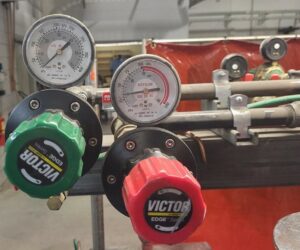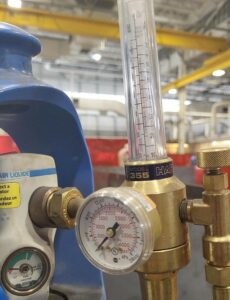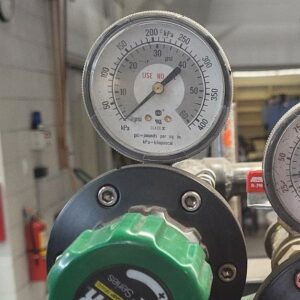25 Gauges
Understanding Gauges
Definitions for gauge:
noun
- an instrument or device for measuring the magnitude, amount, or contents of something, typically with a visual display of such information.
- the thickness, size, or capacity of something, especially as a standard measure.
verb
- estimate or determine the magnitude, amount, or volume of.
- measure the dimensions of (an object) with a gauge.
Gauges Seen in Metal Industry
Gas gauges on compressed gas cylinders
In many welding processes, a gas, or a combination of gases is needed to perform a proper, passable weld. Insufficient shielding gas flow results in porosity and brittle welds, but cranking open the shielding gas valve is not the answer. You can make things worse by using a shielding gas flow that is too high.
Gas bottles used in welding shops have a pressure gauge that measures fluid, gas, water, or steam intensity in a pressure powered machine to ensure there are no leaks or pressure changes that would affect the performance of the system. These pressure systems are designed to operate within a specific pressure range needed for the
process.

Gauge pressure is pressure which is relative to normal atmospheric pressure. It deviates pressure away from standard atmospheric pressure. Gas bottle pressure gauges are measured in several different ways, including bar and psi, and is used worldwide.
Flowmeters indicate the amount of liquid, gas, or vapor moving through a pipe or conduit by measuring linear, non-linear, mass, or volumetric flow rates. Gases are not only used to produce a proper weld, but also to tear them apart.

Oxy-Acetylene fuel cutting is one of the most used, nationwide cutting methods.
Many shops have them set-up in manifolds, but portable individual set ups are not uncommon either. Safety and a precision set up are of the most importance. Take notice to what is done to the various valves and regulators below:
Assemble a portable oxy-acetylene unit


- Secure the cylinders (bottles) to the portable cart with proper rigging
- Remove the cylinder caps and place them aside in a secure spot
- Crack (open slightly and close immediately) the cylinder valves with your face pointed away. This is done before the regulators are attached to clear the valve of dust, dirt or anything unclean that may otherwise enter the regulator.
- Attach the cylinder (bottle) Pressure Regulators. Be sure to not over-tighten.
- Install the flashback arrestors (safety feature)
- Connect the Gas hoses
- Open the cylinder valves
- Purge (blow out) the cylinder pressure regulators and gas hoses. This is a safety procedure that removes any dirt or debris before attaching the torch. Debris in the system can
block small orifices and potentially be flammable - Connect the cutting torch
- Set the working pressure by turning the pressure adjusted screw, until the working pressure gauge reads the preferred working pressure
- Purge the closed system and check for leaks.
Welding gauges

On a completely different note from gas gauges, welders also use a different type of gauge, called a fillet (weld profile) gauge. Most are made of stainless steel, so it doesn’t rust.
Sheet metal
A sheet metal worker deals with meticulous measurements. Sheet Metal workers work with millimeters or inches and different ‘gauges. The gauge systems history starts in the wire industry, to describe the diameter of the metal wire so that wire drawers could quote metal based on the number of draws they had to perform to achieve a certain diameter. Since then, it has become the primary way of describing the thickness of both wire and sheet metal.
IMPORTANT NOTE: the gauge system is completely separate from both the metric and imperial measurement systems.
There are slightly different gauge measurements for different types of metals. The term gauge, in this case, is derived from weight. There are different measurements depending on the type of sheet metal being used, so a conversion chart should be consulted to ensure that the tools and processes being used fit the parameters for the job. A quick way to find the gauge equivalent to a measurement in inches or millimeters is by using a conversion chart like the one below:
Gauge chart
| Gauge | Standard Steel Thickness (inches) | Galvanized Steel Thickness (inches) | Aluminum Thickness (inches) |
|---|---|---|---|
| 3 | 0.2391 | – | 0.2294 |
| 4 | 0.2242 | – | 0.2043 |
| 5 | 0.2092 | – | 0.1819 |
| 6 | 0.1943 | – | 0.162 |
| 7 | 0.1793 | – | 0.1443 |
| 8 | 0.1644 | – | 0.1285 |
| 9 | 0.1495 | 0.1532 | 0.1144 |
| 10 | 0.1345 | 0.1382 | 0.1019 |
| 11 | 0.1196 | 0.1233 | 0.0907 |
| 12 | 0.1046 | 0.1084 | 0.0808 |
| 13 | 0.0897 | 0.0934 | 0.072 |
| 14 | 0.0747 | 0.0785 | 0.0641 |
| 15 | 0.0673 | 0.071 | 0.0571 |
| 16 | 0.0598 | 0.0635 | 0.0508 |
| 17 | 0.0538 | 0.0575 | 0.0453 |
| 18 | 0.0478 | 0.0516 | 0.0403 |
An even easier way to measure the gauge of your materials is by using a material thickness gauge:



